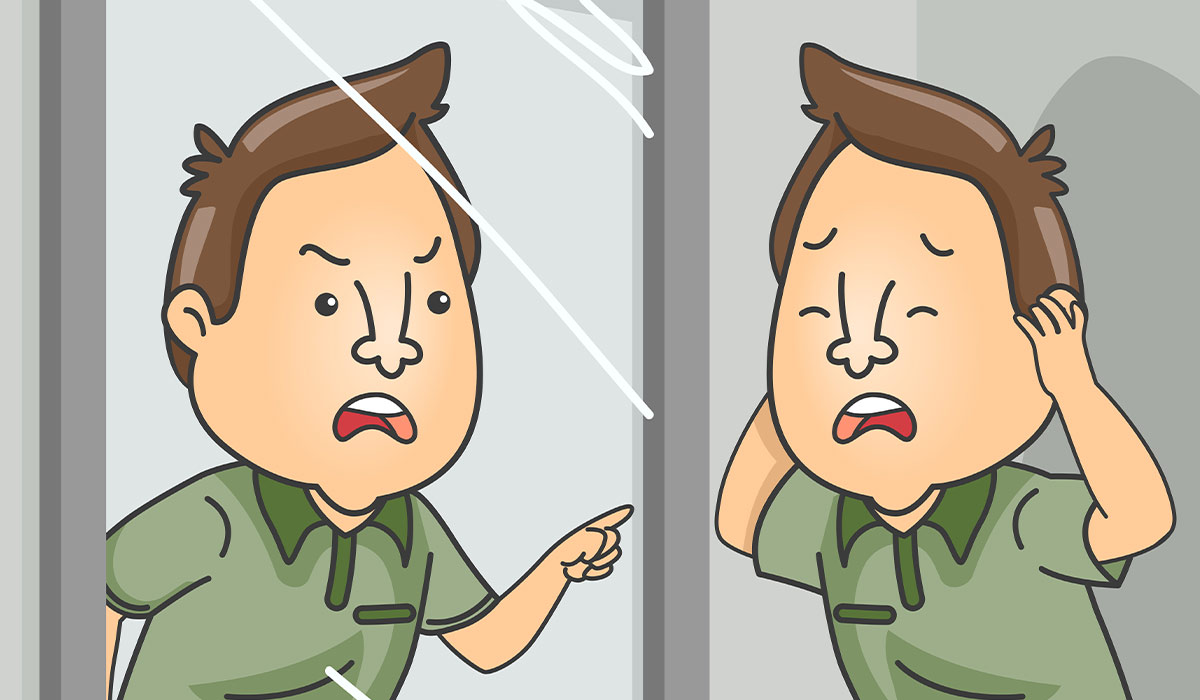Narcissism is manifested by excessive self-presentation and self-absorption. The essential feature of narcissistic personality disorders is an exaggerated sense of one’s uniqueness and importance, preoccupation with dreams of unlimited success, an exhibitionistic need for constant attention and admiration, excessive sensitivity to self-criticism, and self-interest in relationships with others.
What are the signs of narcissistic personality disorder? When should you seek help?
The term “narcissist” and its associated concepts have become a permanent part of modern language and culture. This term originates from Greek mythology and is commonly used to describe people who appear self-confident, socially attractive, and attention-grabbing, often disregarding the needs of others. It is significant to consider whether narcissism is a disorder and how popular perceptions of this condition align with scientific understanding.
According to the concept of the founder of psychoanalysis – Sigmund Freud, the so-called primary narcissism is a natural state of mental organization of every human being at a very early stage of life. Total focus on yourself and your desires and needs related to food, warmth, closeness, and safety. It is an indispensable element of the life of every infant and very young child.

What's more, narcissism as a natural feature of adults has also been extensively studied in psychology – responding to the need to maintain positive self-esteem and care for self-esteem based on premises from the environment. In contrast to these “healthy” manifestations of human narcissism, the disorder is distinguished not by the presence of the above-mentioned characteristics but by their excessive intensity and the dysfunctions/suffering they cause.
In the process of development (approximately from the age of 18 months), we gradually acquire more and more awareness of the surrounding environment, its limitations, as well as the needs of people around us and the compromises between these needs (which is essential for harmonious relationships with others). In understanding narcissism as a disorder, Freud draws attention to the so-called secondary narcissism, which in its appearance resembles childhood narcissism and is perpetuated as a result of disorders in the individual's development (mainly related to the neglect of the child by the caregiver) or by regression (due to frustrations that do not allow for a positive solution to current developmental challenges). This is what we now call narcissistic personality disorder.
Otto Kernberg, another significant researcher of the concept of narcissism, characterizes this disorder as an internal split within the “I” of a person, then dividing into an awe-inspiring grandiose “I” and an empty and shameful “I.” This phenomenon contributes to common symptoms in people suffering from this disorder, such as depressed mood, low self-esteem, substance abuse, and fear of rejection, often interspersed with periods of a fragile sense of grandeur, contentment, and self-sufficiency.
Kernberg also emphasizes the importance of narcissistic traits in different periods of life, which at a younger age may be conducive to professional success (through a constant desire to prove one's worth, a tendency to compete and strive for achievements), and in middle age and old age lead to a sense of emptiness, isolation, and dissatisfaction with the quality of love and relationship life.
It's significant to note that the severity and manifestation of these characteristics can vary among individuals with narcissistic personality disorder. For this reason, the disorder can manifest itself in a variety of ways, ranging from milder forms (the person copes well in most areas of life, and the difficulties manifest themselves only in the area of close intimate relationships – the so-called high-functioning narcissist) to a form in which most important areas of life are destabilized (including certain behaviors of a parasitic or antisocial nature – the so-called malignant narcissism syndrome).
The most important and clearest of these divisions and giving a different clinical picture, however, seems to be Herbert Rosenfeld's distinction between grandiose (“thick-skinned”) and vulnerable (“fragile”) narcissism.
Grandiose narcissists have an inflated sense of self-importance and arrogance and crave attention. They may come across as socially attractive due to their abilities, resources, or physical appearance, but often disregard the needs of others and use them for personal gain. They also lack empathy and the ability to understand other people's perspectives.

They exhibit typical narcissistic traits but also tend to criticize, distrust, and isolate themselves from others. Relatives may perceive them as having a negative attitude toward life and a defensive outlook.
On the other hand, vulnerable narcissists experience distress and inhibition. They are hypersensitive to evaluation, constantly compare themselves to others, and feel inferior and envious. In social situations, they may appear withdrawn and shy while internally believing they are superior.
Identifying narcissistic personality disorder![]() can be challenging, particularly for untrained individuals. This is due to the initial tactics narcissistic people use, which often involve manipulation and a facade of charm. These individuals can be highly charismatic and alluring, making their partners feel exceptional and fulfilled. They may also use flattery, the “mirror technique,” and other methods to gain the trust and loyalty of their partners.
can be challenging, particularly for untrained individuals. This is due to the initial tactics narcissistic people use, which often involve manipulation and a facade of charm. These individuals can be highly charismatic and alluring, making their partners feel exceptional and fulfilled. They may also use flattery, the “mirror technique,” and other methods to gain the trust and loyalty of their partners.
As the relationship progresses![]() , the behavior of those with narcissistic personality disorder changes. Individuals who exhibit self-centered behavior tend to place their own needs and desires above the feelings and opinions of others. They may view others as simply existing to fulfill their desires and need for admiration. These individuals are prone to aggression and may seek revenge when faced opposition. Individuals with narcissistic personality disorder may struggle with a lack of empathy and shallow connections. They may also experience jealousy and devalue the accomplishments of others, believing themselves to be superior. Dependency in relationships is also common.
, the behavior of those with narcissistic personality disorder changes. Individuals who exhibit self-centered behavior tend to place their own needs and desires above the feelings and opinions of others. They may view others as simply existing to fulfill their desires and need for admiration. These individuals are prone to aggression and may seek revenge when faced opposition. Individuals with narcissistic personality disorder may struggle with a lack of empathy and shallow connections. They may also experience jealousy and devalue the accomplishments of others, believing themselves to be superior. Dependency in relationships is also common.
Narcissistic personality disorder is difficult to recognize in the early stages of a relationship. However, there will be some subtle signs. People with narcissistic personality disorder in the early stages of acquaintance show some symptoms of their disorder that they cannot control. Therefore, one should pay attention to whether the recently met person disturbingly often directs the conversation to himself – pays special attention to his achievements and successes, blames other people for his mistakes, tends to humiliate and make fun of less confident people, is critical of former partners and colleagues.
A narcissistic personality disorder may manifest itself in the degrading and arrogant treatment of people who occupy a lower social position than them, while they will willingly refer to acquaintances with influential people who hold high positions, which for many narcissistic people is synonymous with power.
In terms of their value system, they may have difficulty experiencing sadness and feel an excess of shame, leading to severe mood swings. Some individuals may also exhibit antisocial and parasitic behavior without remorse.
These individuals may also experience a constant feeling of emptiness and boredom, leading to a search for intense emotional experiences, sometimes through the use of drugs.

People with sensitive narcissism are more aware of their difficulties and more understanding for others. However, unless they engage in long-term psychotherapy, they too can harm and hurt other people in multiple ways, especially those close to them.
This behavior typically includes:
As with other personality disorders, psychotherapy is considered the primary method of treating this condition, with particular emphasis on psychodynamic![]() and psychoanalytic therapy
and psychoanalytic therapy![]() – due to the fundamental importance of the analysis of the therapeutic relationship in these models. Despite the clinical picture that may be conducive to success in professional and social life, narcissistic people constitute an increasing number of patients undertaking therapy, and its prevalence is about 1% (with more than twice the prevalence among men).
– due to the fundamental importance of the analysis of the therapeutic relationship in these models. Despite the clinical picture that may be conducive to success in professional and social life, narcissistic people constitute an increasing number of patients undertaking therapy, and its prevalence is about 1% (with more than twice the prevalence among men).
People with this disorder come to treatment most often because of depression (associated with the loss of a sense of grandeur, lack of meaning in life, and problems in maintaining relationships) and addiction to psychoactive substances![]() . In some situations (mainly with co-occurring mood disorders), pharmacotherapy conducted by a psychiatrist is also helpful.
. In some situations (mainly with co-occurring mood disorders), pharmacotherapy conducted by a psychiatrist is also helpful.
Psychotherapy of narcissism is possible, but it must be the decision of the person affected by narcissism.
Dealing with a narcissistic personality disorder can be challenging due to the negative emotions it often evokes. A narcissist typically exhibits arrogance, self-righteousness, and manipulative behavior. They are also susceptible to criticism and easily offended, making it difficult to have a harmonious relationship with them. This can be challenging if the person with the disorder is a family member. However, some valuable tips can help.
Most narcissists are proud of their narcissism; they consider it a positive aspect of personality. Although sharing the initial diagnosis may not be received well, the outcome generally improves. Statements like “watch out for your narcissism,” worded without sarcasm, can be effective if the narcissist trusts and values your relationship.
When showing affection to a narcissist, be careful. Narcissists are in great need of compliments, affirmations, and, contrary to appearances, tenderness. However, they can unceremoniously use it once shown submission. It is worth appreciating them and building good behavior in them. Don't be blind to their flaws; don't applaud them. You can't let the narcissist know that you love everything about him uncritically. However, let them feel what you value about them and what you like – a narcissist needs it like air. However, refrain from constantly showing delight or admiration – in this way, you feed his dark side.
Also, don't let yourself be manipulated. Narcissists are masters of lies and manipulation. Maybe that's why they do much better than average people in business – they have a unique imagination and the ability to convince others of their point. However, this has a destructive, not constructive, or creative impact on partner and family life.
The narcissist can convince his partner, including blaming them for all the failures. They will change the subject so cleverly that the conversation will always go their way. You will be surprised at what moment she manages to turn the situation 180 degrees, and you will find yourself guilty of all the evil of this world. Therefore, instead of explaining yourself and apologizing, realize the manipulation and expose this mechanism.
Please don't argue with the narcissist, and don't take what they say personally. Cut the conversation quickly, and don't let yourself feel guilty. Work on your self-esteem. Narcissists often pair up with submissives. As you can easily guess – this is not the best combination. Women with submissive personalities have low self-esteem and quickly submit to people with solid character. People who don't like themselves won't be able to build relationships with others; a narcissist is just such a person. Therefore, do not let them get infected with self-loathing; they will undoubtedly try to do it by humiliating and blaming their partners and undermining their self-esteem.
Set clear boundaries – like terms of discussion. Don't allow anyone in the conflict to back down, get offended, and wait for an apology. It can be helpful to set new rules, for example, “From now on, no offense. We talk until we reach an agreement. We don't interrupt each other. Everyone has an equal right to speak.”
When talking to your loved one about his shortcomings, try to avoid criticism. Talk about yourself and your emotions. Instead of saying, “You're annoying,” say, “I feel irritated when you act like this.” These are seemingly the same, but these messages will differ entirely for selfish people.
If you feel that the problem of narcissism is starting to overwhelm you, start persuading your loved one to go to therapy or, at least see a psychologist.
Have someone outside this relationship support you when things get too complicated. Whether it's a therapist, friend, or family member, their support will strengthen you. And remember, you can't break a narcissist. Ask yourself, do you want to stay in this relationship? These tips may help you function and minimize conflict levels, but the narcissist himself will not change. It's an unequal relationship.
Table of Contents

Borderline Personality Disorder is a severe psychological case that requires appropriate treatment. Learn what type of therapy is available for… read more »

Antisocial personality disorders are mental dysfunctions that result in abnormal behavior of the individual. What are the typical behaviors? read more »

An extrovert is an open and sociable person. The characteristics of this personality type affect various aspects of life. Find… read more »

An introvert is a person with a special personality. Find out about the characteristics of introverts and how being an… read more »

Dissociative identity disorder Ii is characterized by the presence of at least two independent and different personalities in one person.… read more »

Being polyamorous means having relationships with two or more partners. It is not a mental disorder. What does a polyamorous… read more »

Bipolar disorder is a mental disorder characterized by the alternation of extremely different mental states – depression and mania. What… read more »

Munchausen Syndrome is a psychological disorder where an individual deliberately exaggerates, fabricates, or induces physical or psychological symptoms in themselves.… read more »

Post-traumatic stress disorder is a specific psychological reaction to a highly stressful event. How does it manifest itself? What is… read more »